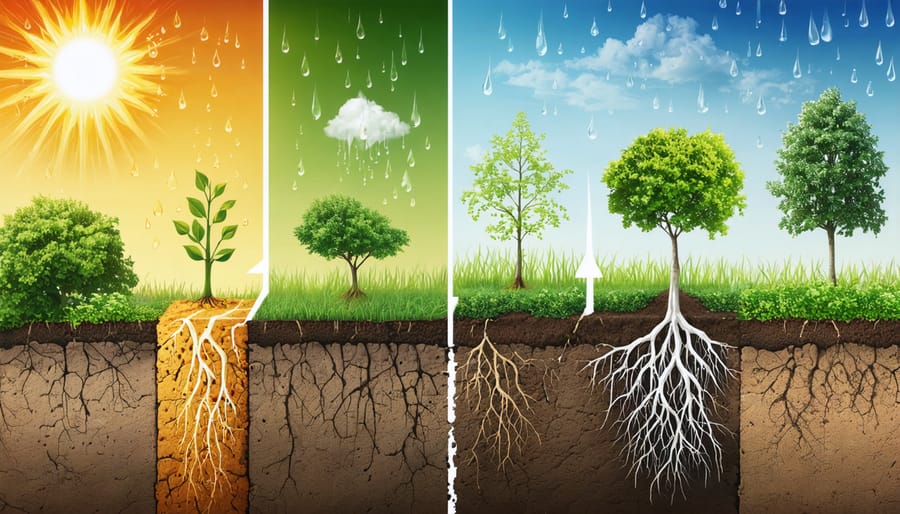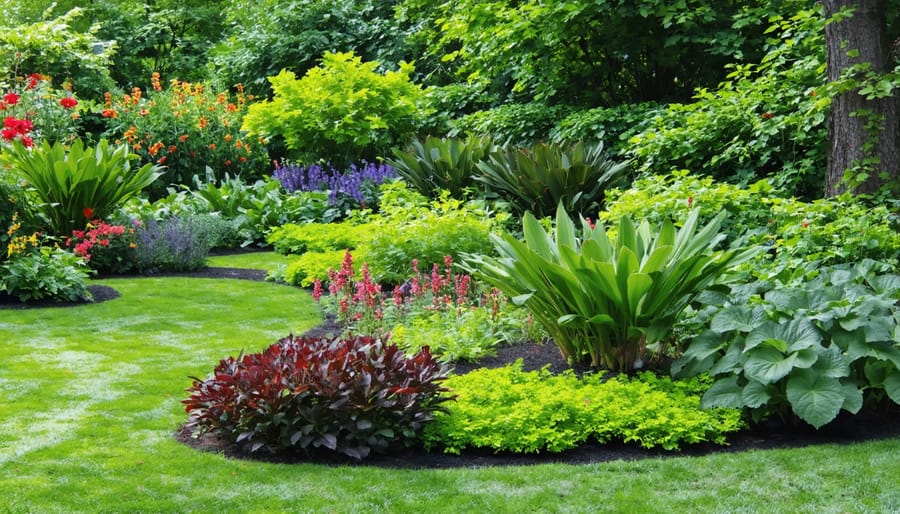Climate shapes your garden’s destiny by orchestrating the intricate dance of soil formation. Every raindrop, temperature swing, and seasonal shift transforms basic rock and organic matter into healthy garden soil. In temperate regions, consistent rainfall and moderate temperatures create ideal conditions for organic matter decomposition, while arid climates produce mineral-rich soils that need specific care to thrive. Understanding your local climate’s role in soil development unlocks the secret to successful gardening—whether you’re growing vegetables in sandy coastal soil or nurturing native plants in clay-rich valleys. This natural process, occurring over thousands of years, continues today in your backyard, influenced by both global weather patterns and your gardening practices. By working with your climate’s soil-forming tendencies rather than against them, you’ll create a thriving garden ecosystem that’s perfectly adapted to your local conditions.
The Five Climate Factors That Shape Your Soil
Temperature’s Role in Soil Chemistry
Temperature plays a vital role in how our garden soil develops and behaves. Think of it as nature’s cooking timer – when temperatures are warm, organic matter breaks down more quickly, just like food composts faster in summer than winter. This breakdown releases essential nutrients that plants need to thrive.
Warmer temperatures also speed up the weathering of rocks and minerals in your soil. As these materials break down, they release important nutrients and create the fine particles that give soil its texture. In cooler climates, this process happens more slowly, which is why you might notice different soil types in your garden compared to friends living in warmer regions.
However, extremely high temperatures can be challenging, as they might cause organic matter to decompose too quickly, leaving your soil lacking in nutrients. That’s why mulching becomes especially important in warm climates – it helps protect the soil and maintain a healthy balance of decomposition.

Rainfall and Water Movement
Rainfall plays a crucial role in shaping your garden’s soil texture and nutrient content. When rain falls, it doesn’t just water your plants – it creates a complex dance of water movement through the soil layers. In areas with heavy rainfall, water gradually washes away (leaches) nutrients from the upper soil layers, making the soil more acidic over time. This process, known as leaching, can leave your soil less fertile unless you regularly replenish nutrients.
In contrast, gardens in drier regions tend to have more alkaline soil because fewer nutrients are washed away. The amount and timing of rainfall also affect how soil particles clump together, influencing whether your soil becomes clay-like or sandy. Understanding your local rainfall patterns can help you make better decisions about soil amendments and drainage solutions for your garden.
Wind and Soil Development
Wind plays a fascinating role in shaping our garden soils, acting like nature’s own sorting system. As it blows across the landscape, it picks up and moves soil particles, with lighter materials traveling farther than heavier ones. This natural process, known as wind sorting, creates distinct soil patterns that many gardeners encounter in their yards.
Think of wind as both a friend and occasional challenge in your garden. While it can help distribute beneficial materials like organic matter across your landscape, strong winds can also lead to soil erosion, particularly in exposed areas. To protect your soil, consider creating windbreaks using trees or shrubs, or maintain good ground cover with plants and mulch.
In drier regions, wind-blown particles can actually help build soil layers over time, depositing fine materials that eventually become part of your garden’s soil structure. However, too much wind exposure can dry out your soil quickly, so it’s important to monitor moisture levels and adjust your watering schedule accordingly.
Seasonal Changes and Soil Structure
As your garden moves through the seasons, you’ll notice fascinating changes in your soil’s structure and fertility. During spring thaws, freezing and thawing cycles create natural tillage, breaking up compacted soil and forming beneficial air pockets. Summer brings increased microbial activity, when warm temperatures accelerate organic matter decomposition and nutrient cycling. Fall’s dropping leaves contribute valuable organic material, while winter’s freeze-thaw patterns help break down tough clay particles and improve soil structure. These seasonal rhythms also affect soil pH levels and nutrient availability, making some times of year better for certain garden activities than others. Understanding these natural cycles helps you work with nature rather than against it, leading to healthier soil and more productive gardens.

Common Climate-Soil Combinations in Home Gardens
Wet Climate Soils
In wet climates, where rainfall is abundant throughout the year, soils develop distinct characteristics that greatly influence gardening practices. These soils typically undergo a process called leaching, where rainwater gradually washes away essential nutrients from the upper layers, making them naturally more acidic.
You’ll notice that wet climate soils often have a deeper, darker appearance compared to those in drier regions. This is because the constant moisture promotes faster decomposition of organic matter, creating rich, deep topsoil layers. However, this same moisture can also lead to challenges – particularly with drainage and soil compaction.
If you’re gardening in a wet climate, you’ll want to focus on improving drainage and maintaining soil structure. Adding organic matter like compost helps create air pockets in the soil, preventing waterlogging and giving roots the oxygen they need. Many experienced gardeners in rainy regions build raised beds or incorporate coarse materials like gravel to enhance drainage.
These soils can be incredibly productive when managed properly. The key is working with, rather than against, their natural tendencies. Consider planting moisture-loving plants that thrive in acidic conditions, and establish a regular soil amendment schedule to replenish nutrients that may have been leached away. A layer of mulch can help protect the soil structure during heavy rains while maintaining consistent moisture levels during drier spells.
Dry Climate Soils
Dry climate soils present unique challenges and opportunities for gardeners. These soils typically develop in areas with limited rainfall and high evaporation rates, resulting in distinctive characteristics that require special attention. You’ll often find these soils are alkaline, with a crusty surface layer and high mineral content, particularly calcium carbonate.
One of the most notable features of dry climate soils is their tendency to be low in organic matter. This happens because the hot, dry conditions speed up decomposition while limiting plant growth that would normally contribute to soil building. However, don’t let this discourage you! With the right approach to managing dry climate gardens, you can create a thriving garden space.
The good news is that these soils often have excellent mineral content and drainage capabilities. To make the most of dry climate soils, focus on building organic matter through regular composting and mulching. A layer of organic mulch helps retain moisture, regulate soil temperature, and gradually improve soil structure.
Consider incorporating drought-resistant native plants that naturally thrive in these conditions. They’ve adapted to make the most of available moisture and can help stabilize the soil. Regular addition of organic amendments, combined with proper watering techniques, will gradually transform even the most challenging dry climate soil into a productive growing medium.
Temperate Climate Soils
Temperate climate soils are nature’s sweet spot for gardening, offering a balanced environment where organic matter can thrive and nutrients are preserved. These soils benefit from moderate rainfall and temperature variations throughout the year, creating ideal conditions for both plant growth and soil development.
Unlike extreme climates, temperate regions experience a perfect mix of warm summers and cool winters, allowing for the gradual breakdown of organic matter. This seasonal cycle helps maintain healthy soil structure and supports beneficial microorganisms that enrich the soil naturally. Many gardeners in temperate zones find their soil has a rich, dark color and crumbly texture – telltale signs of fertile ground.
The key to maintaining temperate climate soils lies in working with these natural processes. Adding compost in spring and fall helps mimic the natural cycle of leaf litter decomposition, while maintaining good drainage prevents waterlogging during wet seasons. Many experienced gardeners recommend mulching to protect soil from temperature extremes and maintain moisture levels.
One of the biggest advantages of gardening in temperate zones is the ability to grow a wide variety of plants. The soil typically maintains a pH between 6.0 and 7.0, suitable for most garden favorites. However, it’s important to remember that even in these favorable conditions, regular soil testing and amendments may be necessary to maintain optimal growing conditions.
Smart Soil Management for Your Climate
Soil Testing and Assessment
Testing your soil is like getting a health check-up for your garden, and it’s easier than you might think! Start by collecting soil samples from different areas of your garden, about 6 inches deep. Mix these samples together to get a representative sample of your entire garden space.
A basic DIY soil test begins with the squeeze test: grab a handful of soil and squeeze it. If it holds its shape but crumbles easily when poked, you’ve got good soil structure. If it stays in a tight ball, it might have too much clay. If it falls apart immediately, it could be too sandy.
For a more detailed analysis, consider purchasing a home testing kit from your local garden center. These kits can measure pH levels, nitrogen, phosphorus, and potassium content. They’re particularly useful for understanding how your local climate has influenced your soil’s characteristics.
For the most accurate results, consider sending samples to your local extension office. They can provide comprehensive soil analysis and specific recommendations based on your climate zone and gardening goals. Remember to test your soil annually, as climate conditions can change your soil’s properties over time.
Climate-Specific Amendments
Making the right soil amendments for your climate can make all the difference in your gardening success. Understanding climate-specific soil management helps you choose improvements that work with, rather than against, your local conditions.
In hot, arid climates, focus on amendments that improve water retention, such as coconut coir or well-aged compost. These materials help soil hold precious moisture while providing essential nutrients. Adding a layer of mulch on top further prevents water loss through evaporation.
For cold climates, incorporate organic matter that breaks down slowly, like pine needles or hardwood bark. These materials gradually improve soil structure while providing insulation for plant roots during freeze-thaw cycles.
In humid regions, prioritize amendments that enhance drainage, such as coarse sand or perlite. Good drainage prevents waterlogging and reduces the risk of root rot, which is especially important in areas with frequent rainfall.
Remember to test your soil annually and adjust your amendment strategy based on the results. Small, consistent improvements often work better than dramatic one-time changes.
Seasonal Maintenance Strategies
Maintaining healthy soil requires different approaches throughout the year, as climate patterns shift and affect soil conditions. In spring, focus on aerating soil as it thaws and adding organic matter to replenish nutrients depleted during winter. This is also the perfect time to test your soil’s pH and adjust it if needed.
Summer maintenance calls for careful moisture management. Mulching becomes crucial during hot months, helping retain moisture and regulate soil temperature. Consider using light-colored mulch in particularly hot climates to reflect excess heat and protect soil biology.
Fall is your soil’s preparation period for winter. Add compost and slow-release organic fertilizers while the soil is still warm enough for beneficial microorganisms to process them. Cover bare soil with winter cover crops or thick mulch to prevent erosion from autumn rains and winter frost.
Winter maintenance varies by region. In mild climates, continue composting and minimal soil work. In areas with freeze-thaw cycles, avoid walking on soil to prevent compaction, and maintain protective mulch layers. Use this time to plan next season’s soil improvements based on the previous year’s observations.
Remember that local climate patterns may require adjusting these strategies to suit your specific conditions.

Climate Change Adaptations
As our climate continues to shift, adapting your soil management practices becomes increasingly important. Start by understanding your local garden climate zones and how they might change in the coming years. Focus on building resilient soil that can withstand both extreme wet and dry periods by increasing organic matter content through regular composting and mulching.
Consider incorporating drought-resistant techniques like adding biochar or water-retaining materials to help soil maintain moisture during dry spells. Creating deeper soil beds can help plants develop stronger root systems, making them more resilient to temperature fluctuations and irregular rainfall patterns.
Installing proper drainage systems becomes crucial as extreme weather events become more common. Consider raised beds in areas prone to flooding, and implement swales or French drains to manage excess water. Adding diverse beneficial microorganisms through compost tea or mycorrhizal fungi can help your soil ecosystem adapt to changing conditions.
Remember to monitor your soil’s health regularly through simple tests and observations. This way, you can adjust your management strategies as climate patterns continue to evolve.
As we’ve explored throughout this article, climate plays a vital role in shaping the soil that nurtures our gardens. Understanding this relationship empowers us to become better stewards of our garden soil and more successful gardeners overall. By paying attention to temperature, rainfall patterns, and seasonal changes in your area, you can make informed decisions about soil management that will help your garden thrive.
Remember that healthy soil is a living ecosystem that responds to climate conditions just as your plants do. Whether you’re dealing with heavy clay in a rainy region or sandy soil in an arid climate, there are always steps you can take to work with nature rather than against it. Start by regularly monitoring your soil’s moisture levels, organic matter content, and overall structure.
Consider implementing climate-smart practices like mulching to regulate soil temperature and moisture, choosing appropriate cover crops for your climate zone, and adjusting your watering schedule to match seasonal rainfall patterns. These small changes can make a big difference in your garden’s success.
Most importantly, be patient and observant. Soil formation is a gradual process, and improvements take time. Keep a garden journal to track changes in your soil over the seasons, and don’t be afraid to experiment with different techniques. Your garden is unique, and finding what works best for your specific climate conditions is part of the rewarding journey of gardening.
Together, we can nurture healthier soils while adapting to our changing climate. Happy gardening!




